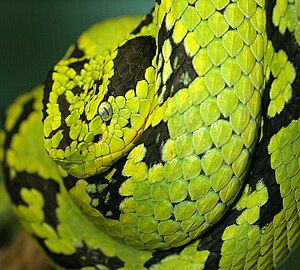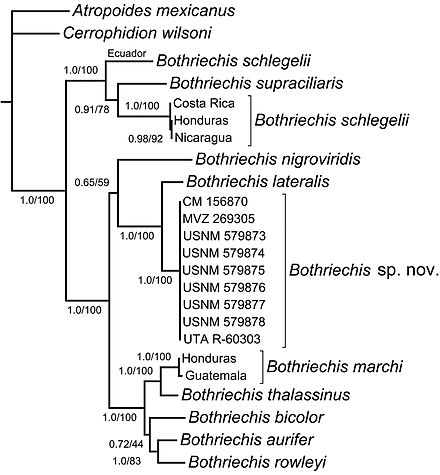Palm lance vipers
| Palm lance vipers | ||||||||||||
|---|---|---|---|---|---|---|---|---|---|---|---|---|

Yellow-spotted palm-lance viper ( Bothriechis aurifer ) |
||||||||||||
| Systematics | ||||||||||||
|
||||||||||||
| Scientific name | ||||||||||||
| Bothriechis | ||||||||||||
| Peters , 1859 |
The bothriechis ( Bothriechis ) are a genus of the family of vipers (Viperidae). Within this they belong to the American representatives of the pit vipers (Crotalinae). The venomous snakes live from Mexico to Central America to Colombia and Venezuela. There are currently eleven species described .
features
The genus of the palm lance viper consists of medium-sized snake species that usually reach body lengths of 60 to 80 centimeters. Only a few individuals grow up to one meter long, with the longest known specimen being a male B. aurifer with a body length of 1.01 meters. A sexual dimorphism occurs in all species . The females are larger than the males in the prehensile- tailed lance viper and the black-spotted palm-lance viper , while the opposite is true for all other species. They are slim built and have a prehensile tail that makes up about 17 percent of the body's length. The snout can be broad and rounded ( B. aurifer , B. rowleyi , B. nigroviridis ) or narrower and elongated ( B. bicolor , B. marchi , B. lateralis ). The head length is 5 to 6 percent of the total length, with the heads of the young animals being proportionally larger.
The basic color of the animals is mostly green to greenish-yellow with light and dark speckles; an exception to this is the prehensile-tailed lance viper , which is very variable in color . In some species, dark blindfolds or yellow patterns appear on the flank scales near the abdomen. The undersides of the scales and the free edges are black, which creates clear drawing patterns. As a rule, young animals are also green in color, but in some species they are brown; this is explained by the adaptation to the respective subsoil of the forest floor, which represents the main area of life of the young snakes. This can be overgrown by undergrowth and moss or covered by leaves and branches, whereby different colors are useful as camouflage.
The snakes have a very sharp canthus rostralis and an almost square rostral shield as further distinguishing features .
Way of life
The palm lance vipers are only snakes that live in the trees of the tropical rainforest. They are adapted to the arboricole way of life due to their long tail, which is optimized for grasping . Like all pit otters, they have special pit organs on the sides of their heads between the nostrils and eyes, with which they can perceive thermal radiation ( infrared radiation ) so that they can also hunt at night. The search for food is also done visually and with the sense of smell. Small mammals and other terrestrial vertebrates are bitten and held in a flash.
Relatively little information is available about the reproductive behavior of the palm lanceolate. Like almost all pit vipers, they give birth to live young animals that are only covered by a thin membrane at the time of birth and are accordingly ovoviviparous . The mother snakes climb down from the trees for birth. The membrane is pierced by the young snakes immediately after birth. These live on the forest floor or in low vegetation and feed mainly on small amphibians, for example on ground-living frogs of the genera Eleutherodactylus and Norops , which they can approach due to their camouflage color. In addition, the young animals of some species have lighter tail tips, which are probably used as bait to attract prey.
distribution
The distribution of the genus is limited to Central America from central Mexico in southeast Oaxaca in the Chiapas area to northern South America to Colombia , Ecuador and Venezuela . The prehensile-tailed lance-viper occurs in the flatlands of the entire distribution area, while all other species are highland species with a very limited distribution area in individual mountain regions. In Costa Rica there is also an island population of the rapturous lance viper.
Taxonomy
History of science
The genus Bothriechis was first described in 1859 by the German naturalist Wilhelm Peters . The type species of the genus was the black-spotted palm lance viper ( B. nigroviridis ), three years later he also described the green and yellow palm lance viper ( B. lateralis ) as another species of the genus. By Müller, however, the genus was dissolved again in 1878 and adopted as a synonym for Bothrops , in which he classified all Central and South American pit otters with the exception of rattle-bearing rattlesnakes and dwarf rattlesnakes .
A revision of the genus Bothrops sensu lato as well as the new description of the genus Bothriechis and other genera classified in Bothrops only took place again in 1971 by Burger in his unpublished dissertation. In 1992 Steven D. Werman took up this and carried out a phylogenetic analysis of the South American pit vipers. An analysis of the genus Bothriechis itself on the basis of molecular biological and morphological characteristics was also carried out in 1992 by Brian I Crother, Jonathan A. Campbell and David M. Mills.
species
Ten species are recognized in the genus Bothriechis after the revision of the former large genus Bothrops sensu lato by Burger in 1971 and Steven D. Werman in 1992. Werman also classified the monotypical genus Ophryacus with the species Ophryacus undulatus in the palm lance viper , but could not establish this. A new species B. thalassinus from Guatemala and Honduras was described by Campbell & Smith in 2000, but ignored by Campbell & Lamar in 2004. In 2013 Bothriechis guifarroi was described.
| German name | Scientific name | distribution | Hazard level Red List of IUCN |
Remarks | image |
|---|---|---|---|---|---|
| Yellow-spotted palm-lance viper |
Bothriechis aurifer ( Salvin , 1860) |

|
|
monotypically distributed in Mexico , in mountain rainforests and cloud forests at altitudes of 1200 to 2300 meters, in the mountains of eastern Chiapas and northern Guatemala . |

|
| Two-colored palm lance viper |
Bothriechis bicolor ( Boucourt , 1868) |

|
|
monotypical distribution from southeast Chiapas in Mexico to southern Guatemala. Also at some sites in Honduras , in cloud forests at heights of 500 to 2000 m. |

|
|
Bothriechis guifarroi Townsend , Medina-Flores , Wilson , Jadin & Austin , 2013 |
Northern Honduras. |
|
monotypical |

|
|
| Green-yellow palm lance viper |
Bothriechis lateralis Peters , 1862 |
Cloud forests and mountain rainforests in Costa Rica and Panama at altitudes of 1200 to 2300 meters. |
|
monotypical |

|
| March's palm lance viper |
Bothriechis marchi ( Barbour & Loveridge , 1929) |
In north-western Honduras and eastern Guatemala, in forests at altitudes of 500 to 1500 m. |
|
monotypical | |
| Black-spotted palm-lance viper |
Bothriechis nigroviridis Peters , 1859 |
In Costa Rica and Panama in the mountains at altitudes of 1150 to 2400 m meters. |
|
monotypical |

|
|
Bothriechis nubestris Doan , Mason , Castoe , Sasa & Parkinson , 2016 |
In the highlands of Costa Rica. |
|
monotypical | ||
| Rowley's palm lance viper |
Bothriechis rowleyi ( Bogert , 1968) |

|
|
monotypically distributed in Mexico in southeast Oaxaca and in northern Chiapas, in cloud forests at altitudes of 1500 to 1830 m. |

|
| Raptic lance viper |
Bothriechis schlegelii ( Berthold , 1846) |
Central America, from central Mexico to Panama and the extreme northwest of South America in parts of Colombia , western Ecuador and in a small area in Venezuela . |
|
monotypical |

|
|
Bothriechis supraciliaris ( Taylor , 1954) |
Costa Rica. |
|
monotypical | ||
| Sea-blue palm lance viper |
Bothriechis thalassinus Campbell & Smith , 2000 |
Guatemala, Honduras at altitudes of 1370 to 1750 m. |
|
monotypical |

|
supporting documents
- ↑ a b c Josiah H. Townsend, Melissa Medina-Flores, Larry David Wilson, Robert C. Jadin and James D. Austin. 2013. A relict lineage and new species of green palm-pitocket (Squamata, Viperidae, Bothriechis) from the Chortís Highlands of Mesoamerica. ZooKeys . 298: 77-106, doi: 10.3897 / zookeys.298.4834
- ↑ Steven D. Werman: Phylogenitic Relationships of Central and South American Pitvipers of the Genus Bothrops (sensu lato): Cladistic Analyzes of Biochemical and Anatomical Characters. In: Jonathan A. Campbell, Edmund D. Brodie Jr .: The Biology of the Pitvipers. Selva, Tyler (Texas) 1992; Pages 21-40. ISBN 0-9630537-0-1
- ↑ Information from Crother et al. 1992
- ^ A b Jonathan A. Campbell, EN Smith: A new species of arboreal pitocket form the Atlantic versant of northern Central America. Revista de Biologia Tropical 48, 2000: 1001-1013.
- ↑ Tiffany M. Doan, Andrew J. Mason, Todd A. Castoe, Mahmood Sasa, and Christopher L. Parkinson. 2016. A Cryptic Palm-Pitocket Species (Squamata: Viperidae: Bothriechis ) from the Costa Rican Highlands, with Notes on the Variation within B. nigroviridis. Zootaxa. 4138 (2) DOI: 10.11646 / zootaxa.4138.2.3
literature
- Jonathan A. Campbell, William W. Lamar: The Venomous Reptiles of the Western Hemisphere. Comstock; Ithaca, London. 2004. ISBN 0-8014-4141-2
- Brian I Crother, Jonathan A. Campbell, and David M. Mills: Phylogeny and Historical Biogeography of the Palm-Pitvipers Genus Bothriechis : Biochemicals and Morphological Evidence. In: Jonathan A. Campbell, Edmund D. Brodie Jr .: The Biology of the Pitvipers. Selva, Tyler (Texas) 1992; Pages 1-20. ISBN 0-9630537-0-1
